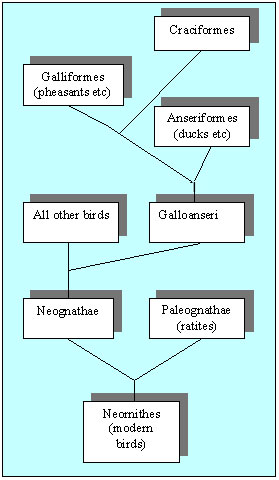The Sibley-Ahlquist taxonomy is a radical new approach to bird
taxonomy based on DNA studies which gives an arrangement differing greatly from
the more traditional approach. The major changes in classification of birds at order level are as follows:
-
ANSERIFORMES - unchanged
- Enlarged STRUTHIONIFORMES replaces the ratite orders
Rheiformes rheas, Casuariiformes cassowaries, and Apterygiformes kiwis and
Struthioniformes ostriches
- New enlarged CICONIIFORMES includes the previous
Sphenisciformes
penguins, Gaviiformes
divers, Podicipediformes grebes,
Procellariiformes tubenoses,
Pelecaniformes
pelicans & allies, Ciconiiformes storks &
allies, Falconiformes birds of prey, Charadriiformes waders gulls terns and auks.
- New CRACIFORMES chachalacas etc. Previously Galliformes
This revolutionary reordering in classification of birds has been widely accepted
by North American ornithologists, including the American Ornithologists' Union, but in other parts of
the world its effect has been more evolutionary: it has been a respected major influence on existing
classification schemes, as opposed to a complete replacement for them.
 A more recent
paper looked at the ancestry of bird groups. The traditional view of avian evolution places ratites and
tinamous at the base of the tree of modern birds (Neornithes), followed by old
marine groups such as the penguins, grebes and divers (loons). The new research suggested that the ducks
and gallinaceous birds are each other's closest relatives and together form the basal lineage of
neognathous birds. The ratites and tinamous will now be followed by the ducks and their allies, and then
the pheasants and their allies. This latter research has been accepted by the British Ornithologists'
Union, and their list will now start with Anseriformes and Galliformes. A more recent
paper looked at the ancestry of bird groups. The traditional view of avian evolution places ratites and
tinamous at the base of the tree of modern birds (Neornithes), followed by old
marine groups such as the penguins, grebes and divers (loons). The new research suggested that the ducks
and gallinaceous birds are each other's closest relatives and together form the basal lineage of
neognathous birds. The ratites and tinamous will now be followed by the ducks and their allies, and then
the pheasants and their allies. This latter research has been accepted by the British Ornithologists'
Union, and their list will now start with Anseriformes and Galliformes.
The Sibley-Monroe checklist, multiple parts:
Above article originally from Wikipedia and is available under GNU Free Documentation License
|
|








 A more recent
paper looked at the ancestry of bird groups. The traditional view of avian evolution places ratites and
tinamous at the base of the tree of modern
A more recent
paper looked at the ancestry of bird groups. The traditional view of avian evolution places ratites and
tinamous at the base of the tree of modern